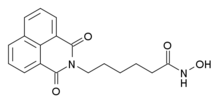Scriptaid
Scriptaid is a drug which acts as a histone deacetylase inhibitor, and was one of the first compounds discovered via high-throughput screening that acts at this target.[1] Scriptaid itself was never developed for medical applications, but led to the development of structurally related drugs such as vorinostat which have been accepted into clinical use. Most early research using these compounds focused on their anti-cancer activity,[2] but more recent research has found scriptaid to be useful in other applications such as cloning and research into regulation of metabolism.[3][4][5][6]
 | |
| Clinical data | |
|---|---|
| ATC code |
|
| Identifiers | |
IUPAC name
| |
| CAS Number | |
| PubChem CID | |
| ChemSpider | |
| Chemical and physical data | |
| Formula | C18H18N2O4 |
| Molar mass | 326.347 g/mol g·mol−1 |
| 3D model (JSmol) | |
SMILES
| |
InChI
| |
References
- Su, G. H.; Sohn, T. A.; Ryu, B; Kern, S. E. (2000). "A novel histone deacetylase inhibitor identified by high-throughput transcriptional screening of a compound library". Cancer Research. 60 (12): 3137–42. PMID 10866300.
- Monneret, C (2005). "Histone deacetylase inhibitors". European Journal of Medicinal Chemistry. 40 (1): 1–13. doi:10.1016/j.ejmech.2004.10.001. PMID 15642405.
- Wang, G; Jiang, X; Pu, H; Zhang, W; An, C; Hu, X; Liou, A. K.; Leak, R. K.; Gao, Y; Chen, J (2013). "Scriptaid, a novel histone deacetylase inhibitor, protects against traumatic brain injury via modulation of PTEN and AKT pathway : Scriptaid protects against TBI via AKT". Neurotherapeutics. 10 (1): 124–42. doi:10.1007/s13311-012-0157-2. PMC 3557358. PMID 23132328.
- Zhu, X; Nie, J; Quan, S; Xu, H; Yang, X; Lu, Y; Lu, K; Lu, S (2016). "In vitro production of cloned and transgenically cloned embryos from Guangxi Huanjiang Xiang pig". In Vitro Cellular & Developmental Biology - Animal. 52 (2): 137–43. doi:10.1007/s11626-015-9957-0. PMID 26559066.
- Rissi, V. B.; Glanzner, W. G.; Mujica, L. K.; Antoniazzi, A. Q.; Gonçalves, P. B.; Bordignon, V (2016). "Effect of Cell Cycle Interactions and Inhibition of Histone Deacetylases on Development of Porcine Embryos Produced by Nuclear Transfer". Cellular Reprogramming. 18 (1): 8–16. doi:10.1089/cell.2015.0052. PMID 27281695.
- Gaur, V; Connor, T; Sanigorski, A; Martin, S. D.; Bruce, C. R.; Henstridge, D. C.; Bond, S. T.; McEwen, K. A.; Kerr-Bayles, L; Ashton, T. D.; Fleming, C; Wu, M; Pike Winer, L. S.; Chen, D; Hudson, G. M.; Schwabe, J. W.; Baar, K; Febbraio, M. A.; Gregorevic, P; Pfeffer, F. M.; Walder, K. R.; Hargreaves, M; McGee, S. L. (2016). "Disruption of the Class IIa HDAC Corepressor Complex Increases Energy Expenditure and Lipid Oxidation". Cell Reports. 16 (11): 2802–10. doi:10.1016/j.celrep.2016.08.005. PMID 27626651.
This article is issued from
Wikipedia.
The text is licensed under Creative
Commons - Attribution - Sharealike.
Additional terms may apply for the media files.